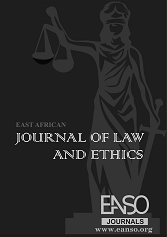Evaluating the Adversarial System in Tanzania Mainland: A Human Rights and Access to Justice Perspective
Abstract
The adversarial system underpins Tanzania's legal framework, particularly in criminal trials as established under Section 209 (2), 66 (a)(ii), 198 of The Criminal Procedure Act. While designed to ensure fairness through party-driven litigation, it often fails to uphold human rights, especially for indigent and uneducated defendants. This study employs a mixed methodological approach, integrating doctrinal legal research with comparative legal analysis, grounded in Cappelletti and Garth's access to justice theoretical framework. This article critically evaluates the adversarial system's impact on the right to a fair trial, access to justice, and protection against self-incrimination in the Tanzania Mainland. Drawing on Tanzanian statutes, case law, and international human rights standards, through systematic examination of primary legal sources and comparative analysis with Germany's inquisitorial system, it identifies challenges such as limited legal representation, judicial delays, and aggressive cross-examination. Proposing a hybrid system integrating adversarial and inquisitorial elements, the article advocates for reforms to enhance judicial oversight, expand legal aid, and relaxed-evidence rules. A comparative analysis with Germany's hybrid model strengthens the case for reform, ensuring Tanzania's justice system aligns with human rights principles and promotes equitable access to justice
Downloads
References
Constitution of the United Republic of Tanzania (1977, as amended).
Basic Law for the Federal Republic of Germany (1949, as amended)
Books
Cappelletti M, Access to Justice: The Worldwide Movement to Make Rights Effective (Giuffrè 1978).
Chipeta BD, A Handbook for Public Prosecutors (Mkuki na Nyota 2009).
Ingraham BL, The Structure of Criminal Procedure: Laws and Practice of France, the Soviet Union, China, and the United States (Praeger 1987).
Langbein JH, The Origins of Adversary Criminal Trial (Oxford University Press 2003).
Mirindo F, Administration of Justice in Mainland Tanzania (Law Africa Publishing 2010).
Twaib F, Legal Profession in Tanzania: The Law and Practice (UDSM Press 1997).
Vogler R, A World View of Criminal Justice (Ashgate Publishing 2005).
Weigend T, The Criminal Process: An International Literature Review (KLI 2016)
Statutes
Code of Criminal Procedure (Strafprozessordnung) 1987, (as amended).
Criminal Procedure Act [Cap 20, R.E. 2023].
Economic and Organised Crime Control Act [Cap 200, R.E. 2023].
Evidence Act [Cap 6, R.E. 2023].
Judicature and Application of Laws Act [Cap 358, R.E. 2023].
Legal Aid Act [Cap 21, R.E. 2023].
Ward Tribunals Act [Cap 206, R.E. 2023].
Covenants and Charters
African Charter on Human and Peoples’ Rights (1981).
African Commission on Human and Peoples’ Rights, Guidelines on Combating Sexual Violence and Its Consequences in Africa (2017).
African Commission on Human and Peoples’ Rights, Principles and Guidelines on the Right to a Fair Trial and Legal Assistance in Africa (2003).
Council of Europe, European Convention on Human Rights (1950).
United Nations, Convention Against Torture and Other Cruel, Inhuman or Degrading Treatment or Punishment (adopted December 1984).
United Nations, International Covenant on Civil and Political Rights (adopted December 1966).
United Nations, Standard Minimum Rules for the Treatment of Prisoners (Nelson Mandela Rules, 2015).
Case Law
Avocats Sans Frontières v Burundi (2017) ACHPR 56/2016.
Dickson Paulo Sanga v R [2019] TZHC 45.
Maulid v R [2019] TZCA 123.
M.E. v Germany (2004) ECHR 456.
R v David Flynn [2008] EWCA Crim 970, [2008] Cr App R 17 (England and Wales Court of Appeal).
Republic v Mussa Mwaikunda [2005] TLR 387.
Salabiaku v France (1988) 13 EHRR 379.
Reports
German Bar Association, Legal Aid Statistics 2022.
Legal and Human Rights Centre, Tanzania Human Rights Report 2023.
World Justice Project, Rule of Law Index 2024. Washington, DC.
Copyright (c) 2025 Joseph Bornventure

This work is licensed under a Creative Commons Attribution 4.0 International License.




























